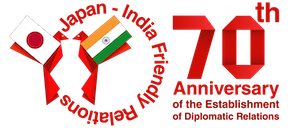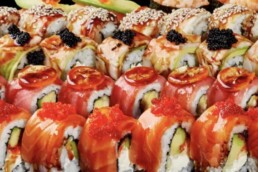Mr. Atusi Kohara Jr. works as a Japanese cuisine chef at Wasabi by Morimoto, a Japanese restaurant in a five-star hotel, “The Taj Mahal Palace,” in Mumbai, India.
He is one of the few Bronze holders for Certification of Cooking Skills for Japanese Cuisine in Foreign Countries(*) in India who works for a Japanese restaurant which specialises in authentic Japanese cuisine using Japanese techniques.
He completed an online class of Japanese Food and Food Culture Human Resource Development Program(*) in 2021, provided by JCDC(*), to learn the techniques to cook Japanese cuisine.
We visited Wasabi by Morimoto, where Mr Kohara works, and asked him about his passion for cooking Japanese cuisine, his skills, and the benefits he has gotten from mastering them. Moreover, we had a wonderful opportunity to see the actual preparation and serving of the Japanese dishes.

Career as a Japanese Cuisine Chef for Mr. Kohara
How has been your career as a Chef?
I started in 1999, and it was a coincidence because I had dropped out of my university and I was looking for some jobs. I saw some companies in which they wanted people to cook Japanese cuisine. Then I realised that would be a great idea because I am half Japanese and since childhood I had had a Japanese kitchen at home. I wanted to go for the same. And I found it very cool.
How long have you been in the food industry?
It has been 23 years. I used to work at Starwoods. I started my work in Brazil and then moved to Portugal and the Bahamas, working in big companies like Atlantis, Nobu, Sherton, etc. Now I am here in Taj, Mumbai.
What inspired you to take interest in Japanese Cuisine?
Nihonshoku (Japanese cuisine) for me every time that you have it with your family. When we meet together and visit Grandmother’s house. Nihonshoku (Japanese cuisine) for me is like happiness. It reminds me of old times that I spent with my family. That is my inspiration.

What is something very interesting about Japanese cuisine for you?
I think you can see my size. I am really big because I really eat too much. I like Sushi, Sashimi. Also, I like fries like Tempura, Katsu, and Cochin dashi. It has too much variety for Indian ingredients.
Awareness of Japanese Cuisine in India
According to you, what do you think people in India think about Japanese cuisine?
So, actually, once they think about Japanese cuisine, they first think about the raw fish and sashimi sushi. But after they come for a try and for their first experience, they see that we also have vegetarian foods, so it’s not just about sashimi. We have different types of cuisines, then they get more interested in it and want to try more Japanese cuisines.
What are the most popular Japanese dishes and ingredients among Indian people?
Okay, one of them is yellowtail carpaccio, which is Hamachi, a Japanese fish that comes from Japan.

What kind of menu does your restaurant, WASABI, offers?
Hamachi, Black Cod with miso sauce that people like too much. In Japanese, it is Gindara. Also, spinach with Sesame sauce is very nice.
Can you name one fusion that you are talking about?
Actually, here, you can call it Washoku, but a new Washoku, because it’s as contemporary as our plates coming from Marimoto. He had a vision for Japanese cuisine and created a fusion for Indians to try.
What kind of Japanese ingredients do you currently use in your restaurant?
Actually, 80% of the ingredients come from Japan, like soy sauce, mirin, kombu, and sake, because to make Japanese cuisine we must have Japanese ingredients. Even fish come from Japan.
Japan has high quality of products which makes it a natural choice for us to import fish from Japan.

How is Japanese Cuisine Spreading in India, and How is it Going in the Future?
Now we are working for Japanese food promotion to commemorate the 70th anniversary of Japan and India’s diplomatic relationship. So what do you think about that?
I think that’s very important because even if the two nations are so different they have too much in common. Same if they think about how the people of India eat like rice and dal. Also in Japanese homes, there is soup and rice and other ingredients. Japanese curry, a very popular dish in Japan. After coming to India, they make it in different ways. So, we have too much in common. If you make that friendship stronger and closer, it will benefit us.
What issues or effective measures do you think need to be addressed in order for Japanese cuisine and Japanese food products to be more accepted by the Indian people in the future?
I think about promoting, actually for example, the guests have too much interest in Japanese cuisine even if they have not tried before, because now we can see on Tv about the health because Japanese food is very healthy and different, so people that are looking for different experiences they look for the Japanese food.
Yes, Japanese cuisine is unique cuisine which you can only find in Japanese restaurants. People are scared to try raw fish. If you show people that the raw fish is not really bad, I feel more Indian people will accept it.
Similarly, when I came here and tried Indian food. There was one dish similar to Japanese Dish, Nigaori or Goya from Okinawa. It is a vegetable we have in Japan, something which is in India as well. Karela (Bitter Gourd). I was surprised to see that Indian people knew about it.
About Certification of Cooking Skills for Japanese Cuisine in Foreigner

As you said that you had online classes, so was there any difference between online and physical classes that you attended?
I had to attend it online due to covid. Even if it is online, they show you techniques after which you have to make food online and take pictures to show. For the final test you have to do a streaming in which you show the cuts on the fish. It is similar to physical classes and very interesting.
Yes because if it was online it was very personal. They arranged some legendary Chefs like Nakata San, Yanagihara San and Murata San who are the top level chefs. Having their sign on the certificates and having them talk is amazing.
What do you think are the most important points in learning Japanese cooking techniques?
The most important thing for learning Japanese cuisine, you must commit. You must be willing to learn. If you want to learn, you will be able to do anything. If you work hard for what you want to do, you can do it.

Have you noticed any changes in your awareness or in the reactions of your colleagues and customers, since you were awarded the Bronze last year?
Yes, actually after I got the certificate, some guests look at me and say, “You are Japanese”, then I tell them I am a son of Japanese and not exactly Japanese. They get confused, but when I tell them that I have a certificate of Japanese cuisine chef then they get happy and want to order Japanese food. My managers were very happy. I attended online classes. My executive Chef was also happy.
Before the certifications, I can see that some of my basement was not correct. After that one, I can see where I can fix myself to become better. Just imagine a building, if you don’t have a strong pillar it will fall down. You can see that the certificate makes a strong pillar to achieve a higher level.
Do you think that being certified as a Bronze chef, which is a Japanese government-recognized culinary skill, will lead to career advancement in the future for those who are involved in Japanese cuisine in other countries?
Yes of course, because imagine now that Japanese cuisine is very famous in the whole world. And the different companies looking for Japanese chefs. The certificate from the organisation with a stamp will be amazing. You can show that they have approved you. You also have too much motivation to get jobs.
Click here to watch the interview movie
As a certified chef, do you have any message or advice for young people aspiring to be a Japanese chef?

Okay, the first one is you must work hard and make a certificate that’s amazing, if you want to go to this job. If you think about working hospitality also in Japanese cuisine, your choice is not familiar and it’s not an easy job. If you don’t love your job then you cannot work for it.
For those interested in certification
If you are interested, you may take the online course program for the Bronze certification. Please contact the following accreditation organization for more information.
AAJ (The Association for the Advancement of the Japanese culinary art)
*About JCDC and Japanese Food and Food Culture Human Resource Development Program
The Japanese Cuisine and Food Culture Human Resource Development Committee(JCDC) is a private organisation that offers Japanese cuisine and food culture human resource development programmes to foreigners interested in learning Japanese cuisine.
*About Certification of Cooking Skills for Japanese Cuisine in Foreign Countries
The Japanese Culinary Technique Certification Program is designed to certify foreign national Japanese food chefs and is offered by private certification organisations according to the “Guidelines for Certification of Cooking Skills for Japanese Cuisine in Foreign Countries” established by the Japanese Ministry of Agriculture, Forestry, and Fisheries on April 1, 2016.
Foreign Japanese food chefs who are recognised as having reached a certain level of knowledge and cooking skills in Japanese cuisine can be certified as Bronze, Silver, or Gold according to the skills and experience they have acquired. As of March 31, 2022, a total of 2,068 chefs(20 Gold, 824 Silver, and 1,224 Bronze) have been certified by accreditation organisations around the world as chefs who can appropriately and effectively communicate the appeal of Japanese food and food culture and Japanese agricultural, forestry, and marine products and foods overseas.
*Guidelines for Certification of Cooking Skills for Japanese Cuisine in Foreign Countries https://www.maff.go.jp/j/shokusan/syokubun/tyori.html(Only Japanese)
*Guideline in English
Guidelines for Certification of Cooking Skills for Japanese Cuisine in Foreign Countries (Provisional Translation)(PDF:80KB)
Guidelines for Certification of Cooking Skills for Japanese Cuisine in Foreign Countries (Outline)(Provisional Translation)
(PDF:131KB)



